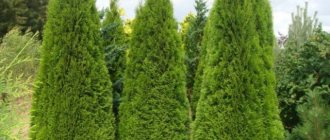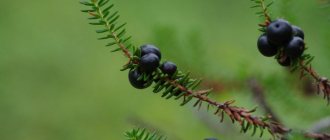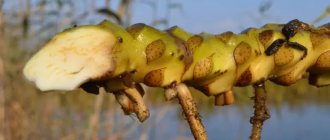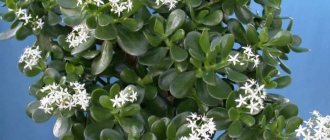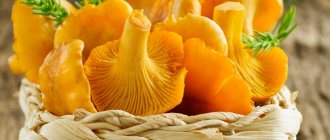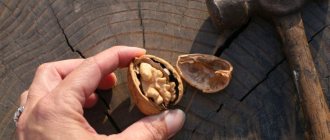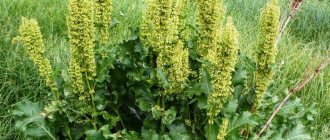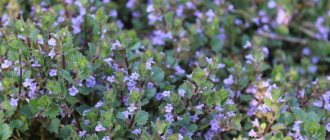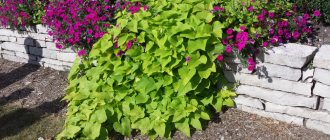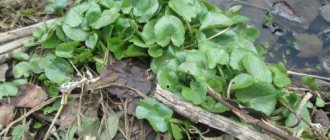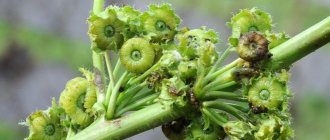In fields and meadows, in gardens and flower beds, a delicate lilac flower with a subtle citrus scent called monarda grows. Latin name Monarda.
This name unites an entire botanical genus of herbs and belongs to the Lamiaceae family.
The name of this genus was given by the 18th century Swedish naturalist and physician Carl Linnaeus in honor of the 16th century Spanish scientist and physician Nicolas Monardes, who published a work on new plants of America in 1574.
Appearance
Among the varieties of the genus Monarda there are both annuals and perennials.
Here is a list of the main external characteristics inherent in the entire botanical genus:
- Stems are straight and branched. Reach up to 15 cm - 150 cm.
- The leaves are lanceolate and light green in color. The location is opposite. The length reaches from 6 to 15 cm, and the width from 3 to 8 cm. The ends of the leaves are pointed.
- Basket-shaped inflorescences. They consist of several flower whorls with a diameter of up to 6-7 cm.
- The flowers are small funnel-shaped tubes. They are painted mainly in lilac, violet, lilac and red. Blooms from June to September.
- The fruits are double dry nuts.
Ground stems are long and horizontal
The botanical genus Monarda includes about 20 plant species. Many of them are often used in gardening.
The most popular are:
- Lemon.
- Double.
- Dudchataya.
- Spot.
- Dwarf.
- Fragrant.
- Average.
- Russell.
- Soft.
- Bradbury.
- Red.
- Comb.
- Absent-minded.
Monarda varieties
Monarda perennial
Varieties of perennial Monarda are very convenient for growing in the garden. These varieties include: Monarda double, Spongy, variety - Panorama. We'll talk about some of them below.
Monarda lemon
An annual bush plant 70-90 cm high. The leaves are green, 4-8 cm long, oval in shape with a sharp tip. Flowers pink, white, purple. If you rub the leaves in your hands, you can smell the lemon aroma.
Variety Monarda – lemon
Monarda fibre
A herbaceous plant 70-120 cm long with serrated leaves. It has highly branched numerous stems. The flowers are lilac in color and 6 cm in diameter. The first flowering occurs in the third year of cultivation.
Variety Monarda – Dutchataya
Monarda doublet
Herbaceous perennial plant reaching a height of 1.5 m. The stem is tetrahedral, erect. The leaves are pale green in color. The flowers have a lilac, violet color. The bark system is located near the soil surface.
Monarda doublet
Variety Citrodera (lemon) Harlequin
Low plants with a height of only 30-35 cm. The flowers are collected in a dense plume and have a characteristic bergamot aroma. Prefers sunny places for growing.
Monarda Citrodera (lemon) Harlequin
Monarda Gardenview scarlet
The plant can reach a height of 1 m and is an excellent decoration for flower beds. The flowers are colored red. Sun-loving plant.
Monarda Gardenview Scarlet
Method of making spices
Consuming monarda spice is one of the many uses of this herb.
To make spices from this plant you need:
- Collect monarda during flowering. It is at this time that its composition contains the maximum content of essential oil.
- Cut stems no shorter than 25 cm from the soil.
- Dry and grind.
- It should be stored, like other spices, in a tightly sealed dry container.
Pests and diseases
Monarda is not susceptible to pest attacks because its essential oils repel insects. However, due to improper care, the crop may suffer from powdery mildew, which occurs due to waterlogging of the soil, and rust.
To get rid of powdery mildew, just adjust the watering regime. When bushes are affected by rust, the soil around the flowers is treated with preparations containing copper.
Perennial in landscape design
Peculiarities
The most characteristic properties of all types of monarda are:
- Mint-lemon aroma, inherent mainly in the trunks and flowers of the plant.
- Honey-bearing property, due to which butterflies, bees and even hummingbirds (in those places where they are found) always circle over the flower.
- The third important quality of monarda, characteristic of the entire genus, is that all flowers contain a huge supply of essential oil. The most meaningful flower in this regard is Monarda didyma.
general description
The homeland of monarda is North America and Mexico, but in central Russia it blooms well and abundantly from July to the end of summer with beautiful pink, red, bright crimson and purple flowers.
The genus Monarda has at least 17 species and more than fifty varieties, but the most famous are the fistula, lemon, double and dotted.
Monarda has bright flowers, collected in 20-50 pieces at the top of the branching stem.
The stem is square, grooved and hard, about 90 cm in height. The leaves are distinctly toothed. Thin, dense fibers cover most of the stem and leaves. The roots are short, thin, creeping.
Beneficial properties of essential oil
These flowers are primarily used to extract essential oil.
Monarda oil has the following medicinal properties:
- It is used as a bactericidal and antiviral agent.
- It is used as a panacea for various types of inflammation.
- Monarda oil is an immunomodulatory tool.
- Has strong antioxidant properties.
- It is an antisclerotic and desensitizing agent.
- An effective antispasmodic agent.
- Another important quality is radioprotective.
- Helps with depression and stress.
- It is an adaptogenic tool.
- Recommended for people with anemia.
- And finally, this is one of the best anti-carcinogenic agents.
If necessary and desired, monarda oil extract can be made at home. This extract is useful during a runny nose and is suitable as a bactericidal agent for treating injuries and wounds.
To make this extract:
- Mix any purified vegetable oil and dried parts of the monarda flower in a ratio of 1:10.
- Prepare a water bath and keep the oil mixture in it for a couple of hours.
- Then cool and strain. The healing oil mixture is ready.
Many of the healing qualities of monarda essential oil can be observed in other herbal oils. For example, tea tree oil has similar healing properties and is also widely used in cosmetology. The aromatic and healing properties of lavender and clove oil are also similar to those of bee balm oil. However, only this oil can normalize the level of oxygen in the body's cells.
Monarda oil is a remedy unique in its medicinal properties:
- This is the first and last scientifically proven oil that can treat radiation sickness and protect against radiation. People with radiation sickness are recommended to drink teas with bee balm oil.
- This tea also helps people with cancer after chemotherapy.
Article on the topic: Spring buttercup - beneficial properties, description
However, only a doctor can prescribe such people to drink this tea.
Monarda oil is also used in the following cases:
- During acute respiratory diseases and bronchial asthma as an antibacterial and anti-inflammatory agent. You can treat yourself with aromatherapy, adding drops of oil to aroma lamps, or through inhalation.
- To enhance the effect of antibiotics and speed up the healing process. To increase the effect of aroma lamps, you can add eucalyptus oil. For aroma lamps, a drop of monarda oil per 15 square meters will be enough. Please note that aroma lamps with monarda oil are contraindicated for pregnant women and children under 5-6 years of age.
- For the treatment of wounds, burns, ulcers and even fractures. A mixture of oils helps with broken bones. To make it you need 10 ml. wheat germ oil, 5 drops of monard oil and 2 drops of lavender oil. The fracture site should be smeared with this mixture or a compress should be made from it. For wounds, you need to mix a teaspoon of vodka with five drops of monard oil and wash the wound several times during the day.
- To get rid of worms. To do this, just mix 1 ml of glycerin oil and two drops of monarda oil. Smear and rub them into your stomach.
- From foot fungi. To do this, mix a tablespoon of vegetable oil with monardova. 5 drops will be enough. Apply to problem areas of your feet and put on socks. Do not remove for 2-3 hours.
Monard oil can also be used:
- As an effective rejuvenating agent. Thanks to its composition, it is able to quickly renew the body’s cells and slow down the aging process. As an anti-aging remedy, it is ideal to massage with monarda oil, or add it to face and body creams. To enhance the effect, you can add rose and lime oils.
- For oily and dry skin. It normalizes the functioning of the sebaceous glands, tightens pores and eliminates acne. Add a few drops of oil to facial toners and lotions and you will see the effect.
- This is an excellent tonic, a source of strength and vigor. Helps with chronic fatigue. To restore strength and energy, massage all parts of the body with monarda oil.
- On the farm for the destruction of mold. To get rid of black mold in living areas, which is often observed in damp houses, dilute 15 drops of oil with 1 liter of water. Treat the premises with a sprayer containing this liquid at least once a week.
Monarda: reproduction
There are several reliable ways to obtain new planting material:
- Reproduction of Monarda by seeds. As mentioned earlier, Monarda is grown by seeds only in the southern parts of the country. Sowing is carried out in February and by the end of April you can get well-developed seedlings.
- By dividing the rhizome. In autumn, a well-developed rhizome is divided into several parts and planted in a pre-fertilized hole.
- Using cuttings. Cuttings 9-10 cm long are prepared from young shoots and placed in a box with damp sand and placed in a dark place. After 3 weeks, the cuttings form a root system and can be planted in a permanent growing location.
Monarda tolerates transplantation in the spring quite easily and therefore young bushes can be transplanted to a new growing location.
Monarda doublet
Monarda doublet is, as they say, two in one: a very cute flower and a very useful plant. It is no secret that herbal tea prepared from Monarda bifolia has antipyretic and analgesic properties, especially for pain in the gastrointestinal tract. This is probably why such a simple crop has gained unprecedented popularity among amateur gardeners.
Previously, other names were more well known: Virginian oregano and Canadian oregano. And only now the monarda was named just that. Monarda received its name in honor of the Spanish doctor and botanist Nicholas Monardes, who was the first to officially register it when compiling a catalog of the most useful American plants. People call Monarda bergamot, mountain balsam, American lemon balm and Indian feather.
This flower came to us from North America. Monarda duplicata is a meter-tall perennial with an elongated, spreading root and tetrahedral shoots covered in many hairs. The leaves of this flower grow opposite each other on short cuttings with red outgrowths. The size is about six to twelve centimeters. The leaves are round in shape with light jagged edges. The inflorescences of this plant are small in size, purple or lilac. This flower also has fruits - dry, which, after ripening, fall apart into 4 small nuts.
The Monarda genus includes more than twenty different species, most of which grow in Canada, Mexico or North America. These flowers can be either short-lived or perennial, both even and spreading. The highest growth possible for the Monarda genus is one and a half meters. There is more variety in the colors of the inflorescences: the flowers can be white, pinkish, purple or yellow. The fruit is always a nut. Monarda is characterized by a delicate, aromatic odor reminiscent of citrus and mint (the specific aroma depends on the type).
Today this plant is quite popular. Double monarda, for example, is used for various purposes: from decorative (decorating a site) to culinary (as a spice). Don't forget about the medicinal properties. For example, it is used to combat ARVI or to lower the temperature. The most famous varieties: lemon monarda, fragrant, double, dotted, red, Russell and others.
Monarda double is considered the tallest and most famous variety among the entire family. The bright pointed flower caps can be of several shades - from classic red to snow-white. All the beauty of this plant is demonstrated by photos of double monarda.
Article on the topic: Flat-leaved nettle - beneficial properties, description
Monarda fistulata. It is valued for its essential oils and high content of thymol, a substance that is actively used to create all kinds of medicines used in medicine and beekeeping, as well as perfume and cosmetics.
Lemon monarda is a specimen that is very interesting for gardeners, because it is used not only to decorate a summer cottage thanks to its amazing heavenly-hued flowers, but also as a spice that can add a special flavor to vegetable dishes. By the way, similar oil is found in the leaves of basil, mint, dill and other herbs.
Panorama mixture - beautiful fragrant flowers create a wonderful decorative effect. Cut flowers of this variety do not fade in a vase for a long time.
Planting monarda in open ground
You need to choose a place with good lighting, protected from cold air currents. However, monarda grows well in shade. There are no special requirements for the soil, but for better development it is advisable to choose airy soil with the presence of lime. Garden bergamot will not grow well in very moist soil with a high pH.
In autumn it is necessary to prepare the site:
- Dig up, clear of weeds.
- Per sq. m add 2-3 kg of peat and manure, 40-50 g of phosphorus, 20-30 g of easily soluble salt, 40 g of lime.
Planting in spring:
- Add 20-30 g of nitrogen-containing mixture per square meter. m.
- Plant sprouts with 3 pairs of true leaves at a distance of 60 cm.
- Water generously.
A distinctive feature is winter hardiness (-25 ° C). If the temperature is lower, they need to be covered with polyethylene to create greenhouse conditions. Flowering can be observed after a year. Some varieties are able to form buds in the same season with good care.
Growing
Planting and caring for double monarda will bring the desired results if you choose the right territory for its growth. This plant loves sunlight and does not like exposure to wind. Therefore, the area should be well lit and fenced as much as possible. Of course, this flower will grow in the shade, but it will bloom more strongly only on the sunny side.
Monarda double flowers
Now a few words about the soil: this crop does not grow well in waterlogged soil. In addition, it must be fertilized every fall. Before planting the plant in one of the spring months, the soil needs to be prepared in the fall. More detailed tips on planting and care can be found in the video on the topic.
The seeds of this flower are planted approximately in March. They clear the bed of snow drifts, warm the soil using thermal film, loosen furrows half a meter long and fill them with sand. After planting, the holes are also covered with sand.
Growing and care
Monarda does not have high requirements and rarely causes problems when grown. The plant prefers sunny positions (then flowering is more abundant, but monardas also grow well in partial shade).
Soil preparation
The soil should be fertile, rich in humus and nutrients, and moderately moist. As a soil, you can use a peat substrate with the addition of clay (15-30%) and loosening material (0-20%), for example:
- perlite,
- sand,
- composted pine bark.
Soil pH should be at 5.8-6.5.
Planting and care
Monarda obtained from seeds or cuttings should be planted in open ground in autumn or spring at a distance of 50 × 50 cm (even more space should be allocated to monarda).
Plants can be planted in pots:
- one at a time - in pots with a diameter of 12-15 cm;
- 2-3 plants - in pots of 3-5 liters.
3-4 weeks after planting the monarda, it is recommended to trim the shoot above the second pair of leaves, which stimulates the plants to better tillering.
Feeding
It is preferable to add a slow-acting multicomponent fertilizer to the substrate with additional iron content at a dose of 1.5-3 kg/m³. In the case of young seedlings, after the formation of the first true leaves, it is recommended to feed them with multicomponent fertilizers in the dose indicated on the product packaging. From the end of September, plants should be introduced into the rest period, reduce the amount of watering, and do not fertilize.
Watering
During drought, plants should be well watered. An important treatment is mulching, which limits the evaporation of water from the soil and prevents the growth of weeds.
These perennials root very shallowly, so during drought and insufficient watering, the lower layer of leaves turns yellow and falls off.
Light and temperature
In order for monarda to bloom, it does not necessarily need to go through a period with low temperatures, but cold during the dormant period has a positive effect on its early and abundant flowering and compact crown. Cooling should last 9-12 weeks at 0-5°C.
Monarda is a long-day plant and requires 14 hours of daylight to flower. In March, you can begin to accelerate the onset of flowering by maintaining a temperature of 15-18 °C during the day and 8-13 °C at night for 7-10 weeks. Growth retardants can be used once during cultivation.
After flowering
After flowering, faded inflorescences should be cut off, then in the fall the plant can bloom again. Regular removal of faded inflorescences will prolong the flowering period.
Frost resistance, wintering
The frost resistance of monarda depends on the type - as a rule, the plant tolerates the climate of the Middle Zone well. However, in any case, it is recommended to add mulch before frost sets in.
Pests and diseases
Monarda is quite resistant to pests. Unfortunately, it can be threatened by fungal diseases.
The biggest drawback of plants is poor resistance to powdery mildew. The symptom is a white coating visible on the leaves. Monardas are especially susceptible to powdery mildew when the ambient temperature changes frequently. It is important to constantly monitor the leaves and react immediately if the first lesions are detected.
To prevent the disease you need:
- do not allow the soil to dry out, especially in hot weather;
- ensure free air flow between plants;
- Remove infected leaves and stems to prevent the spread of the disease.
The following varieties are more resistant to powdery mildew:
- Purple Ann,
- Elsi's Lavender,
- Petit Delight,
- Colrain Red,
- Marshalls Delight,
- Raspberry Wine,
- Squaw,
- Violet Queen.
If you replant monardas every 3-4 years, they will bloom well and will not get sick.
Varieties susceptible to powdery mildew are pruned short above the ground immediately after flowering. This significantly reduces susceptibility to disease and helps maintain a compact shape. Parts of plants infected with powdery mildew should not be put into compost.
Other diseases of Monarda:
- rust (Puccinia menthae) - small brown spots appear on the leaves, orange clusters of fungal spores on the underside of the leaf;
- leaf spot (Cercospora sp.).
Pests attacking monarda:
- Spider mite (Tetranychus urticae) - as a result of the mite's feeding, yellow-brown spots are visible on the upper side of the leaf.
- Nettle bug (Orthezia urticae) - a plant attacked by this pest (June), grows slowly and blooms weakly.
- Green beetle (Cassida viridis) – the beetle makes visible holes in the leaves.
Usage
Monarda duplicata can be safely called a cure for seven diseases; it is not without reason that it is actively used as a means of traditional medicine. If you take a closer look at the composition of the plant, everything will become clear. The healing properties are due to the high content of vitamins C, B1, B2 and beneficial essential oils, which perfectly relieve the symptoms of colds, help heal eczema and wounds in general, fight dandruff (decoction for rinsing) and even treat bronchitis and asthma.
Other problems for which using Monarda will give good results:
- Inflammatory processes on the mucous membranes of the oral cavity.
- As a solution for gargling for sore throat.
- To reduce inflammation due to acne, teenage acne and various bacterial diseases of the skin, even foot fungus.
- Drinking in case of food poisoning, dehydration.
We won’t even mention how to use it in everyday life. Decorative varieties of monarda are known for their original beauty, and in cooking it is an indispensable seasoning for all kinds of soups, meat dishes, salads and canned food. If we talk about other purposes of using monarda, then it can save you from the hassle of mold and mildew in the room. For treatment, it is necessary to spray the affected surface with an aqueous solution with monarda oils once every seven days. Fifteen drops of ether are required for 1 liter of water, and soon your problem will be eliminated.
Growing monarda from seeds
Sowing
In the southern regions, the seeds of such a plant are sown directly into open soil on a fine February day. Over the course of a couple of cold months, the seeds will undergo natural stratification. In April, friendly shoots should already appear; they will need to be thinned out. If there is snow cover on the site, it must be removed. Then the ground should be covered with film so that it warms up thoroughly. Afterwards, the soil is loosened, adding a small amount of sand. After this, the seeds are combined with sand (1:4) and sowed. You also need to pour a layer of sand on top of the seeds. Seeds should be planted no more than 25 mm deep into the soil. Sowing in open ground is sometimes done in the autumn, after the seeds have been collected. In spring, when the shoots appear, all that remains is to plant them. After a year, the monarda will grow, become stronger and begin to bloom. Shoots appear extremely slowly.
Seedling
But often such a flower is grown through seedlings. In order for the seedlings of such a plant to be ready for spring planting, they must be planted in January–February, and the boxes should be filled with soil mixture for vegetable crops. The seeds should be buried 20–25 mm. The container is placed in a greenhouse, in which the air temperature should not drop below 20 degrees. The first seedlings can be seen after 20 days, and they begin picking them after another 20 days, using a 4x4 or 3x3 scheme.
Monarda: its medicinal properties and contraindications
Monarda is one of the herbaceous plants whose healing properties were known in ancient times. The flower was often used as a medicine, and was also added to food as a spice. Monarda emigrated to our country in the 19th century, and for a long time had a decorative purpose. Today the plant is widely used to treat various ailments, strengthen the immune system, and solve cosmetic problems. Let's take a closer look at the useful plant.
What it is
Monarda is a very pretty plant with a wonderful fruity, minty aroma, whose 90-100 cm long stems produce magnificent crown-shaped flowers in mid-to-late summer in various colors, including red, pink and purple. In addition to its decorative qualities, monarda is valued for its culinary and medicinal properties.
All above-ground parts of the plant are edible and are used in cooking as a flavoring, as an additive to tea, and to decorate the finished dish with flowers.
What does a monarda look like - photo
Description, history, varieties
The flower belongs to the Lamiaceae family and grows in fields and meadows. The plant was given wide popularity and its name by the Swedish naturalist Carl Linnaeus. Monarda was named in honor of Nicholas Monardes, who in the 16th century wrote a work on new flowers and plants of America.
Monarda has the following appearance: straight stems, lance-shaped leaves of light green color, basket-shaped inflorescences, flowers presented in the form of funnel-shaped tubes, can be painted in various shades of lilac. The plant bears fruit in the form of dry nuts.
Today there are about 20 plant varieties, including both perennial and annual flowers. The most popular are the following:
- Monarda doublet - distributed in America, Asia, and Europe. It is a perennial plant type;
- Monarda fistula - has a special pronounced citrus aroma. The flower is not only decorative, but also medicinal;
- lemon monarda - also has a pronounced citrus aroma, which is reflected in the name of the plant. Blooms well in bright places;
- dwarf monarda - in most cases used for the production of spices.
Use in landscape design
The crop is planted in flower beds, ridges or on the lawn. Growing monarda flowers in mixborders looks quite impressive.
The plant goes well with rudbeckia, perennial phlox, bells and large daisies. Spreading monarda bushes can be supplemented with cereal plants.
Advice! Monarda bushes can be used to decorate fences and fences.
Perennial looks good on lawns
Medicinal properties and contraindications
The plant is a real storehouse of useful substances; it contains healing essential oils, biologically active compounds, and groups of vitamins. Thanks to this, the flower has a wide range of beneficial properties:
- bactericidal effect;
- antiviral effect;
- immunomodulatory effect;
- antioxidant properties;
- anti-sclerotic agent;
- antispasmodic effect;
- radioprotective effect;
- eliminates depressed emotional state, helps fight depression;
- anticarcinogenic agent.
Article on the topic: White sweet clover - beneficial properties, description
Depending on the purpose, monarda can be used in dry form, in the form of a decoction, or in the form of essential oil. Monarda oil is a remedy that can fight radiation sickness and protect the body from radiation effects. Eating the plant also helps people restore their body after chemotherapy.
The use of monarda in folk medicine
Home medicine recommends using the plant for digestive and colds. There are several recipes with good effectiveness.
From parasites
The following infusion is beneficial for worms and salmonellosis:
- two large spoons of herbs are brewed with 500 ml of boiling water;
- keep covered for two hours;
- filter through cheesecloth.
The entire volume of the drug is divided into five equal parts and taken within 24 hours until the condition improves.
For a cold
Inhalation of an infusion of the plant brings a good effect against influenza and acute respiratory viral infections. The recipe looks like this:
- three large spoons of raw material are poured into 500 ml of water;
- boil over medium heat for seven minutes;
- cool slightly.
You need to breathe hot steam for ten minutes. Inhalations should be slow and shallow, otherwise the procedure will lead to burns of the mucous membranes.
For pneumonia
The benefits of monarda for the human body are manifested in cases of pneumonia. Traditional medicine recommends this infusion:
- three large spoons of dry grass are poured into 1 liter of boiling water;
- keep covered for three hours;
- filter through folded cheesecloth.
You need to take the product three times a day, 100 ml. The infusion is also beneficial for asthma and tuberculosis.
For nail fungus
Monarda has antifungal properties and helps improve the condition of the nail plates. First of all, it is recommended to rub a drop of plant oil into the affected areas three times a day for ten days.
Another method suggests doing foot baths regularly. To do this you need:
- add three drops of monarda oil to 1 liter of hot water;
- add two drops of iodine and three large spoons of sea salt;
- mix.
The feet should be kept in such a bath for half an hour; it is advisable to repeat the procedure at least three times a week.
For toothache
The healing properties of monarda are beneficial for inflammation of the oral cavity and toothache. The plant decoction is prepared as follows:
- 25 g of dry herb is poured into 250 ml of boiling water;
- boil in a water bath for 20 minutes;
- cool and pass through cheesecloth.
The product is used for rinsing up to five times a day. The decoction relieves pain well and fights bacterial processes.
In case of poisoning
The medicinal properties of the monarda plant help get rid of nausea and diarrhea in case of poisoning, the herb removes toxins and waste from the body. For medicinal purposes, tea is prepared with leaves:
- 15 g of dry raw material is poured into a glass of hot water;
- insist for ten minutes;
- filter through cheesecloth.
You need to drink the product up to three times a day on an empty stomach until the condition improves.
For neurosis
Monarda has a calming effect and helps relieve stress and get rid of insomnia. The medicinal drink is made as follows:
- a small spoon of leaves is poured with 250 ml of boiling water;
- leave covered for ten minutes;
- filter and cool.
The product should be divided into three equal portions and drunk throughout the day.
If desired, you can add sugar or honey to the monarda infusion
Areas of application of the flower
In most cases, the plant is used to treat respiratory diseases. Monarda has an anti-inflammatory effect, eliminates the symptoms of the disease, and accelerates recovery. In this case, treatment occurs through inhalation or aromatherapy.
The flower accelerates regeneration processes in the body, which is why it is used for burns, ulcers and fractures. The wounds must be washed with drops of oil, and compresses are applied to the fractures.
Monarda is widely known as an anthelmintic. Apply the oil to your stomach and rub in well. This will get rid of worms. The plant will also be effective in the fight against foot fungus.
- mouth rinse to treat inflammatory processes;
- elimination of eating disorders;
- treatment of abscesses;
- eye wash;
- elimination of inflammation in gynecological ailments;
- elimination of bacterial diseases of the feet;
- with pneumonia;
- tuberculosis;
- anemia;
- to eliminate chronic fatigue syndrome - an excellent tonic, allows you to restore vigor and strength.
The flower can also be useful in everyday matters. A solution of plant oil with water can effectively combat mold, a common problem in living spaces with high humidity.
The flower is also widely used in cosmetology. It has been scientifically proven that monarda inhibits the aging process and rejuvenates the body's cells. Therefore, the flower has become a frequent ingredient in masks, creams and tonics. The oil can be used to care for the entire body. It is often applied during massage.
Monarda is effective in combating problem skin. Using the plant allows you to eliminate pimples, acne, narrow pores and normalize the activity of the sebaceous glands.
What are the benefits of monarda?
The plant has numerous beneficial properties. When used according to proven recipes, the herb:
- promotes skin and tissue regeneration;
- stops bleeding;
- improves colds and flu;
- helps to recover faster after operations and serious illnesses;
- increases immune resistance;
- has a mild analgesic effect;
- fights inflammation and bacterial processes;
- has an antiparasitic effect.
You can use the beneficial properties of the monarda plant to strengthen blood vessels and regulate blood pressure. Herbal remedies promote weight loss and are used in weight loss diets.
Medicinal properties of lemon monarda
Lemon monarda is actively used, primarily in cooking. However, the plant also has medicinal properties. Decoctions, infusions and oils based on it are used to treat respiratory diseases. Lemon monarda improves digestion, eliminates bacterial processes in the stomach and intestines, and helps with helminths.
Medicinal properties of monarda binata
The medicinal properties of Monarda duplicata lie in its strong antiseptic effect. First of all, the plant is used for rinsing for coughs and sore throats, as well as externally for treating wounds. You can take teas and herbal infusions to generally strengthen the immune system and for intestinal flatulence.
Medicinal properties of Monarda fistula
Medicinal properties and contraindications of the fistula monarda is used for expectoration when coughing and for inflammation of any nature. The valuable qualities of the flower are in demand in the treatment of wounds and burns, and for skin diseases.
You can wash your hair with decoctions and infusions of monarda to get rid of dandruff.
What is useful for women
The medicinal properties and contraindications of red monarda are in great demand for women. The plant has an analgesic effect and improves the condition of painful menstruation. The natural hormones in the herb provide benefits during menopause, reducing the frequency of hot flashes and strengthening the cardiovascular system.
However, the plant should not be consumed during pregnancy; it can adversely affect the fetus. The same applies to the lactation period; in order to avoid allergies in a child, the flower can only be used externally.
What is useful for men
Flavonoids in monarda provide preventive protection against prostate cancer and reduce the likelihood of its development. In addition, the plant prevents the occurrence of cardiovascular diseases, helps cleanse and strengthen blood vessels, and prevents blood clots.
What are the benefits of monarda in tea?
When added to black or green tea:
- helps eliminate swelling;
- helps restore water-salt balance;
- relieves intestinal colic and spasms;
- regulates blood pressure and equalizes heart rate.
In addition, the plant gives tea a pleasant aroma and unusual taste. The drink with the addition of dried flowers can be consumed either hot or chilled.
Can it be given to children?
Monarda can be used to strengthen children's immunity and improve digestion. However, children under 6 years old should not offer infusions and decoctions based on the plant to children. The flower can provoke severe allergies or irritate the mucous membranes.
Attention! The plant has a number of contraindications. Before giving Monarda to a child for the first time, you should consult a pediatrician.
Healthy recipes
In cooking, the herb is most often used in dry form. It is added as an ingredient for pickles and preservation, used as greens for salads, and added to teas. To prepare a hot drink, you need to chop the inflorescences and leaves of the plant, add lemon and mint, pour boiling water and let it brew for about 20 minutes.
Monarda can be used as a dressing for first courses. Leaves, stems and even inflorescences of the plant are suitable for this. The flower can also be used dry.
The plant fits well into light salad recipes. For example, spring salad: lemon balm branches with leaves, green onions, sour cream, boiled eggs, monarda leaves. The ingredients are crushed and mixed together. Monarda along with green onions is sprinkled on top.
In the summer, a buttermilk cocktail will be a healthy and extremely tasty cocktail. To do this, dilute 4 cups of buttermilk with one glass of water, add a tablespoon of chopped herbs, and you can add vanillin to taste. Shake the contents and refrigerate for 20 minutes.
Tip: the plant can also be used on the farm. Add monarda flowers to your pantry where you store vegetables. This will help preserve the contents longer. It is recommended to set the dried flower on fire and fumigate trees in the garden. This will get rid of aphids. The herb infusion is used to spray the garden and kill parasites.
Use in medicine - simple recipes
- for foot fungus - apply the plant oil to a cotton swab and make a compress on the affected area. Wash off after an hour;
- for wound healing - pour boiling water over 100 g of chopped herb, let it brew, strain. Apply the liquid to areas near the wounds. The boiled pulp should not be thrown away; it can be applied to a bandage and applied to the wound;
- to relieve stress - pour a tablespoon of the herb into a glass of boiling water, let it brew, take a spoonful before meals;
- for colds - pour boiling water over the crushed flowers and leaves of the plant and inhale;
- for problem skin – dilute 15 drops of oil in 500 mg of warm water and wipe your face.
How to choose and how long to store monarda
When purchasing fresh shoots, pay attention to their condition:
- Avoid buying plants with faded flowers, limp stems and leaves.
- The stem must be strong and elastic.
- The flowers are bright pink, purple, yellow or soft white.
Fresh monarda can be stored for several days at room temperature and about a week in a paper bag in the refrigerator.
To preserve flowers for a long time, it is better to dry them. In this case, the smell will become less intense, but the beneficial properties and taste will remain the same.
To prepare the dried spice, tie a bunch of monarda shoots with an elastic band and hang them on a string, crown down, in a warm, ventilated room with dry air.
Dried monarda should be crushed and stored in airtight containers or glass jars in a dark, cool place. In this way, flowers can be stored for up to 2 years.
Harvesting monarda grass
The plant as a raw material begins to be collected after it begins to bloom. Only the lower branches are trimmed so as not to spoil the appearance of the bush. Dry in a dark, ventilated area, crumble and put in a jar.
This article describes the type of plant - Monarda duplicata - this is a very interesting, and most importantly useful plant. It’s not bad if it grows in a garden plot. Especially necessary for those who like to drink aromatic herbal teas.
You can buy monarda grass in our medicinal herbs store in the monoherbs section.
Available Herbs 2021 Read previous article: Uses of Marigolds
Monarda after flowering
How and when to collect seeds
Monarda seeds ripen into nuts in late August or early September. If you want to do breeding work, you can collect them and sow them immediately or grow seedlings that can be planted in the ground in the spring. Or you can save the seeds to sow in a year or two, since the germination period of monarda seeds if properly stored is three years. We remind you that varietal monarda seeds do not retain their parental properties; only species plants are grown generatively.
- Planting flowers for seedlings in February
Preparing for winter
If you don't need monarda seeds, leave the fruits on the bushes - they will be very useful to hungry birds in the fall. The remains of annual monarda species are disposed of, and the site is prepared for a crop that will be grown next year. Monarda is a perennial winter-hardy, it can withstand frosts down to -25 ºC, but if you are afraid that the winter will be not only cold, but also snowless, insulate the area with a thick layer of mulch or cover it with spruce branches.
